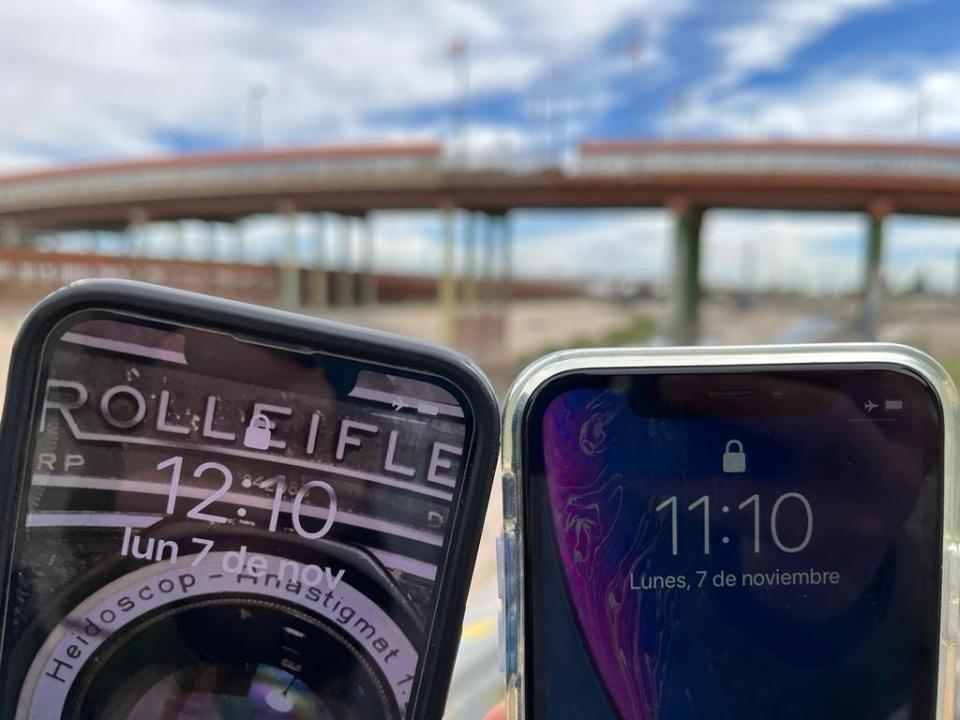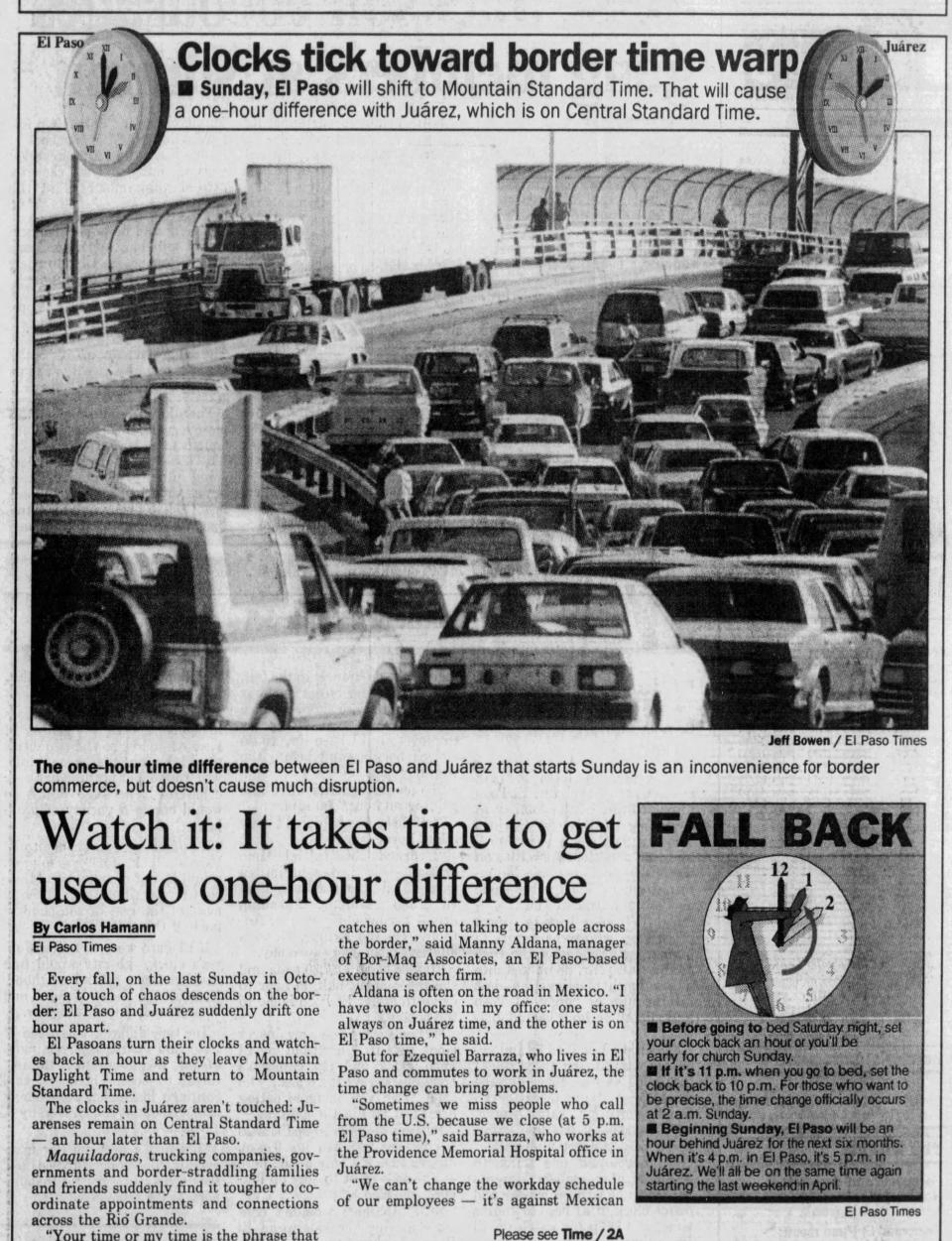Daylight saving time causes confusion, issues at the southern border as Texas, parts of Mexico now out of sync
Texas and parts of Mexico fell out of step this week after the hour regressed in Texas and remained unchanged in Chihuahua, adding another layer of logistical gymnastics to the border crossing routine.
For more than two decades, the sister cities of El Paso and Juárez have kept their clockwork the same and residents sane, "springing forward" and "falling back" together on the same day and hour, as one. Thousands of Borderland residents crisscross with such frequency that gaining or losing an hour multiple times per day provoked an immediate, collective mental strain when the El Paso returned to Mountain Standard Time and Juárez stayed in daylight savings time over the weekend.
It appears it was all a big mistake.
The Mexican congress passed a law on Oct. 30 eliminating daylight saving time in 26 states. The law granted exceptions to the country's northern border states but failed to include its largest border state, Chihuahua.
Related: What is the future of daylight saving time? Year-round change depends on federal vote.
More: Is daylight saving time healthy for you? No, experts say, pointing to lost sleep
"Federal representatives from Chihuahua didn't present the required accord regarding standardizing the hour with our counterpart border communities," said Rogelio Ramos Guevara, president of the business association CANACO in Juárez. "By contrast, the representatives from Tijuana did."
Unlike Tijuana, Nuevo Laredo and other Mexican border cities granted exceptions under the new national time scheme, Juárez was unable to roll back its clocks on Nov. 6.

"It takes us back to the old days before El Paso and Juárez stayed on Mountain Standard Time," said Jerry Pacheco, president of the Border Industrial Association. "Back then it was chaos. So many people would set an appointment and forget Mexico was on a different time part of the year."
The "old days" were before the North American Free Trade Agreement took effect in 1994, when trade across the entire U.S.-Mexico border was a fraction of what it is today in the "Borderplex" region encompassing El Paso, Santa Teresa and Juárez.
Today, every month, between 65,000 and 75,000 cargo trucks pass through El Paso's two commercial ports of entry, according to an analysis of data by Border Region Modeling Project at UTEP.
The personal ties between the two cities are evident in the data: In August alone, El Paso international bridges logged roughly 1 million personal vehicle crossings and 400,000 pedestrian crossings, according to the data analysis.
More: Can the clocks changing affect your mood? How to cope with the impact of a time change
More: Daylight saving time is 'not helpful' and has 'no upsides,' experts say
The Chihuahua state agency that manages the fast northbound SENTRI lanes changed its working hours from 7 a.m. to 1 a.m., instead of 6 a.m. to midnight, to match the hours worked on the U.S. side. But many businesses in Juárez are constrained by labor laws and can’t easily shift work schedules to mirror those of clients and suppliers in El Paso.
The time change was front page news in Juárez on Sunday in El Diario, along with a call for Juárez and Chihuahua elected officials to get the congress to add the state to its list of exceptions.
On Monday, the newspaper published an editorial conceding it could have been worse: Had Juárez fallen an hour behind El Paso instead of remaining an hour ahead, it would have been even harder for juarenses to get to school and work on time in El Paso.
"That doesn't ameliorate the pain or the powerlessness that people feel having to combine activities on both sides in this border community, in which, in the case of the new time zone, was divided in two, as if instead of being one region we were two isolated cities," the editorial said.
On Monday, border commuters posting in the Reporte de Puentes Facebook group, with more than 313,000 members, jumped into the habit of noting “El Paso time” and “Juárez” in their morning bridge traffic reports. One member identifying as Jerry Vazquez-Todd tagged his post with a photo from the top of the Paso del Norte bridge and a quip: “Just here casually time traveling.”
There is always the potential for friction at the temporal dividing line between time zones and regions that observe daylight saving time or not.
For example: Arizona doesn't observe daylight saving time, while the Navajo Nation located within its state borders does. But it's hard to find another metropolitan area as populated and integrated as El Paso and Juárez existing in separate time zones. (For one year in 1965, St. Paul opted out of daylight saving time while Minneapolis carried on, leaving the Twin Cities famously, albeit briefly, out of whack with each other.)

The time zone troubles between El Paso and Juárez may not last long, Ramos Guevara said. The cross-border business community has exerted tremendous pressure on Chihuahua's federal representatives to "fix the omission," he said and by Sunday, Nov. 13, the problem could be corrected.
"They have presented an initiative to return us to the time we were on before," he said. "It's just a matter of procedure."
For now in the Borderland, time travel — if only an hour into the "future" or an hour into the "past" — is entirely possible.
This article originally appeared on El Paso Times: Daylight saving time: Texas, Mexico out of sync in border time change

